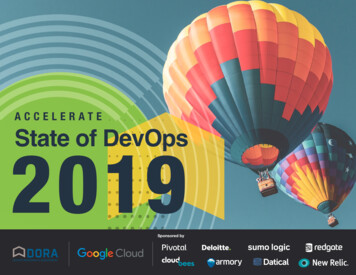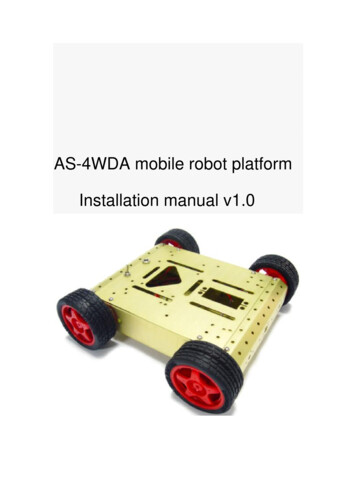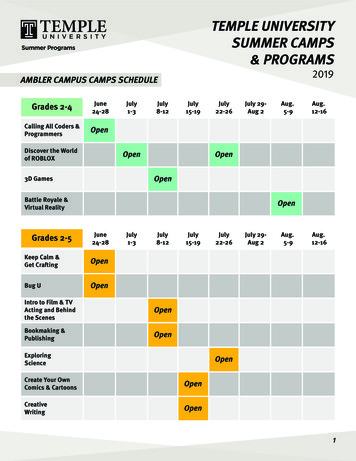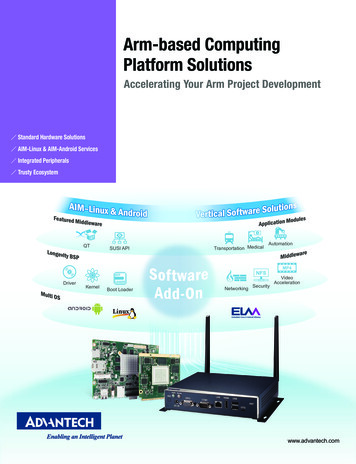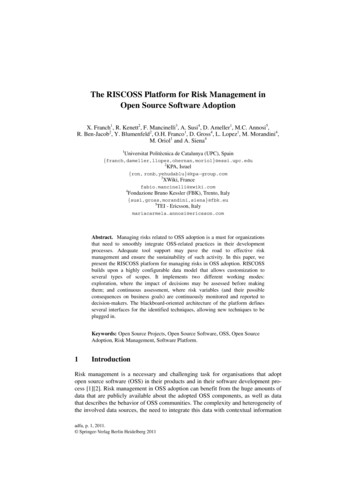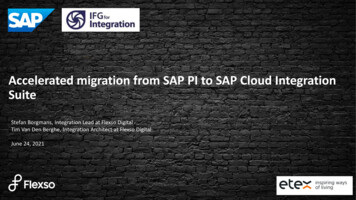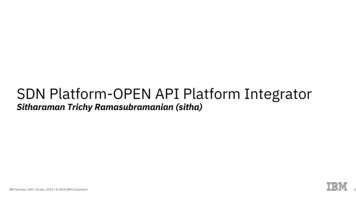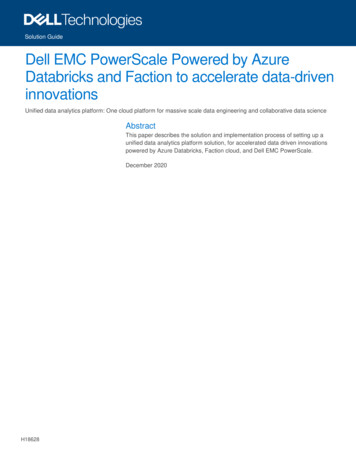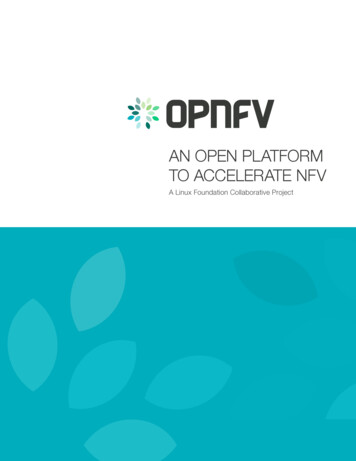
Transcription
AN OPEN PLATFORMTO ACCELERATE NFVA Linux Foundation Collaborative Project
OPNFV: An Open Platform to Accelerate NFVTABLEOF CONTENTSExecutive Summary.3Contributing Organizations and Authors.4Introducing OPNFV.5The Benefits of OPNFV.6Leveraging the Economies of Scale.7Interoperability.8Business Agility.8Approaching the Challenge.9The OPNFV Architectural Framework.10Virtual Network Function Interfaces to thePhysical Hardware (Vl-Ha).11Interfaces Used by the Applications to Executeon Virtual Infrastructure (Vn-Nf).12Interfaces between the Virtual Infrastructureand the VIM (Nf-Vi).12Interfaces from the VIM to the VNF Managersand Orchestration System (Or-Vi and Vi-Vnfm).12OPNFV Distributions.13The User Community.14Major Upstream Projects.15Key Enablers.16Cloud Computing.16Software-Defined Networking (SDN).16The Push towards Open Source.17Call for Participation.18Conclusion.19Contact Information.20References.20Glossary.21
OPNFV: An Open Platform to Accelerate NFVEXECUTIVESUMMARYThe major goal of Network FunctionsVirtualization (NFV) is to increaseservice agility while enabling betterasset utilization.In order to help realize this goal, network operators have called for anopen source reference platform to validate multivendor, interoperableNFV solutions. Open Platform for NFV (OPNFV)1 is a new open sourceproject that will provide such a platform.OPNFV will enable industry collaboration to advance the evolution ofNFV and ensure consistency, performance and interoperability amongvirtualized network infrastructures.OPNFV will work closely with ETSI’s NFV ISG, among other standardsbodies, to drive the consistent implementation of an open and standardNFV reference platform.The initial scope of OPNFV will be to provide NFV Infrastructure (NFVI),Virtualized Infrastructure Management (VIM), and APIs to other NFVelements, which together form the basic infrastructure required forVirtualized Network Functions (VNFs) and Management and NetworkOrchestration (MANO) components.Increasingly, standards are being drafted in conjunction with majoropen source projects. OPNFV will work with many of these projects tocoordinate continuous integration and testing of NFV solutions.1OPNFV web portal: http://opnfv.org3
OPNFV: An Open Platform to Accelerate NFVThis tight coordination of otherwise independent processes is crucialto the establishment of an NFV ecosystem: it can root out issues earlier,identify resolutions, and potentially establish de facto standards. Theresult is a faster and more economical approach to NFV deployment.There is an implicit call for action in the formation of OPNFV and aninvitation is extended to individuals, companies and organizations toparticipate in and contribute to the project. This may include creating codeor providing input (potentially through an advisory board or a technicalsteering committee) to guide the project towards successful industryevolution to more agile and economical networks.CONTRIBUTINGORGANIZATIONS &AUTHORSPrimary Authors:Ericsson:Intel:Christopher PriceSandra RiveraCollaborative Authors:Alcatel Lucent:Brocade:Cisco:Huawei:Intel:Nokia Networks:Red Hat:Asaf PeledMatt WolpinFrank Brockners, Palani Chinnakannan, Alan SardellaPeixin Hou, Mike YoungPranav MehtaThinh NguyenphuDave Neary4
OPNFV: An Open Platform to Accelerate NFVINTRODUCINGOPNFV“.Network FunctionsVirtualization (NFV)replaces the need forphysical applianceswith virtualized networkfunctions runningon standard serverplatforms.”Open Platform for NFV (OPNFV) is a newproject that intends to provide an open sourceplatform for deploying NFV solutions thatleverages investments from a communityof developers and solution providers.The investments are designed to enable interoperability across a broad setof industry players and usage models. The goal is to create a framework thataddresses the needs of the platform providers, application developers and endusers who will be required to operate and maintain these complex systems.The continuing growth of data traversing the network is well documented,driven by more devices, more users and new usage models such as videostreaming and social media.As a result, network operators are under pressure to build out their facilities to satisfythe demand for services from consumers, enterprises and the Internet of Things.Historically, this has been accomplished by adding purpose-built hardware-basedappliances to the network, a capital and operationally intensive approach to growingand maintaining networks. As described in the joint-carrier white paper published inOctober 20122, Network Functions Virtualization (NFV) replaces the need for physicalappliances with virtualized network functions running on standard server platforms,thereby leveraging server volume economics, standard IT virtualization and cloudtechnologies, and business models which will enable network operators to deployand maintain networks in a more cost-effective and efficient manner.This document describes the role of open source in this endeavor and therationale for the OPNFV initiative.2Original joint-carrier white paper introducing NFV: http://portal.etsi.org/NFV/NFV White Paper.pdf5
OPNFV: An Open Platform to Accelerate NFVTHE OBJECTIVESOF OPNFVThe objectives of OPNFV are twofold:firstly, a collaborative development ofan open source platform to promoteinteroperable NFV solutions; andsecondly, to help stimulate existingopen source communities to create thesoftware code or hardware necessaryto implement NFV solutions based oncommon industry requirements.The overall design of the OPNFV platform should be modular and allow forextensions and innovation beyond the community components, providingchoice to end users for additional value that may be gained from proprietary orspecialized components. The goal is to have an open platform to support variousimplementation models while building on an open substrate for the infrastructurethat provides interoperability between elements from various sources.In the absence of collaboration, individual NFV vendors and users willindependently implement numerous NFV platforms and solutions, making thegoal of industry interoperability difficult to achieve. Such fragmentation will diluteresources and could lead to divergence and gaps, which will not benefit eitherusers of the NFV platform or their customers. Further, key enabling upstreamprojects will likely grow weary of multiple attempts by NFV users to address thesame defects, feature gaps or feature requests coming from a broad range ofvendors and developers. The OPNFV project aims to provide an open referenceplatform for the deployment of Virtual Network Functions (VNF). OPNFV canbenefit its members and community in multiple ways.6
OPNFV: An Open Platform to Accelerate NFVLEVERAGING THEECONOMIES OF SCALE“The goal is to havean open platformto support variousimplementation modelswhile building on anopen substrate for theinfrastructure thatprovides interoperabilitybetween elementsfrom varioussources.”OPNFV acts as an avenue for therealization of NFV requirements viaupstream open source projects,participating and helping to developnecessary improvements to accelerateadoption in network applications.OPNFV will retain a focus on solving real problems, and will providea forum for practical issues to be captured and accommodated inassociated standards bodies and open source communities.The OPNFV project, together with a comprehensive number of investedcorporate members, intends to share the burden of integration, testingand validation of components. This collaboration with the broadercommunity will result in increased industry-wide interoperability, reliabilityand efficiency that will shorten time to market.7
OPNFV: An Open Platform to Accelerate NFVINTEROPERABILITYThe promise of interoperability and the valueof a unified approach are expected to increasethe rate of innovation and accelerate theavailability of commercial NFV solutions.Member companies will be able to implement their own integrated solutionsmore focused on specific use cases and targeted market segments. Customerswill leverage enhanced serviceability, reliability and performance optimization,allowing the larger OPNFV community to focus on modularity and interoperability.Additionally, insights achieved and shared by interoperable solutions willimprove the effectiveness of the converged industry efforts, resulting in codeimprovements and facilitating the resolution of gaps and issues.BUSINESS AGILITYThe implementation of an open referenceplatform for virtualized network functionsallows the industry to focus on thecreation of new business propositionsand enables the rapid development ofunique solutions to address user needs.By building an open reference NFV platform, OPNFV will provide the firstcornerstone to ensure the interoperability of NFV solutions from multiple vendorsand encourage an ecosystem of developers to create new services, and drivenew revenue streams, more quickly and at much lower risk.8
OPNFV: An Open Platform to Accelerate NFVAPPROACHINGTHE CHALLENGEAs the community engages to addressthe overall scope of OPNFV, the projectwill work with other active forums using,validating, and evolving existing NFVreference documents and currentbest practices.The formative community has identified the creation of a reference NFVplatform distribution as an initial, key milestone to be followed by thedevelopment of additional functionality. OPNFV will validate existingstandard specifications, contribute improvements to relevant upstreamopen source projects, and develop necessary new functionality bothwithin OPNFV and upstream projects.OPNFV does not intend to be considered as an alternative to existingstandardization efforts. Rather, OPNFV will be run as a community,complementary to existing standards and open source bodies with aclear focus on the coordination of software development, integrationand testing, documentation and API development for NFV. Of particularinterest to the community are the requirements documented by the ETSINFV Industry Specification Group (NFV ISG).3 Additionally it is expectedthat insights developed within the OPNFV community will be fed back tothe NFV ISG and other relevant bodies.3ETSI NFV ISG portal: gies/nfv9
OPNFV: An Open Platform to Accelerate NFVTHE OPNFVARCHITECTURALFRAMEWORKThe architectural framework underdevelopment in OPNFV is reflected inthe following diagram taken from theNFV ISG Architectural Framework.44ETSI NFV ISG Architectural Framework: www.etsi.org/deliver/etsi gs/NFV/001 099/002/01.01.01 60/gs NFV002v010101p.pdfNFV Management& OrchestrationOrchestratorService, VNF andInfrastructure DescriptionVNF 1OtherReference PointsOs-MaOSS/BSSEMS 1ExecutionReference PointsEMS 2EMS 3VNF 2Main NFVReference PointsSe-MaOr-VnfmVe-VnfmVNFManager(s)VNF geVirtualNetworkNf-ViVIRTUALIZATION LAYERVI-HaHardware ResourcesComputingHardwareStorageHardwareFigure 1: NFV Reference Architectural LFOCUSOF OPNFVNetworkHardware10
OPNFV: An Open Platform to Accelerate NFV“While across theindustry there are manyinitiatives to provide thesecapabilities in proprietaryand public forums,the OPNFV projectwill work to bring thesecomponents togetherto realize a modular andpluggable framework forNFV deployment opento all industry participants.”The OPNFV project will initially focus on what is commonly referred toas the NFV infrastructure layer. The two functional blocks constitutingthe foundations for enabling the deployment of applications running ina virtual environment are the virtualization infrastructure (NFVI) and thevirtualized infrastructure manager (VIM): The NFVI provides access to basic resources—compute, storage andnetworking—through hypervisors and SDN functions. The VIM manages the VNFI and provides the management capabilityrequired to deploy applications running in a virtual environment,commonly referred to as VNFs (virtual network functions).The OPNFV reference platform work, rather than trying to reinvent theseplatform components, will be primarily focused on the alignment of theinterfaces between these components and the delivery of a functionalreference platform.While across the industry there are many initiatives to provide thesecapabilities in proprietary and public forums, the OPNFV project will workto bring these components together to realize a modular and pluggableframework for NFV deployment open to all industry participants.To achieve this, the OPNFV community will focus on the way thesecomponents interact and the interfaces between them. These interfacescan be distilled to four areas detailed in the following sections:Virtual Network Function Interfaces to thePhysical Hardware (Vl-Ha)The goal of creating common interfaces between the platform andunderlying hardware is to allow the decoupling of software from hardware.It is expected that there would be multiple reference implementations thatenable the capability for operators to: Share infrastructure resources for different purposes Reassign resources for different purposes Progress software and hardware in parallel Leverage software and hardware components from different vendors11
OPNFV: An Open Platform to Accelerate NFVInterfaces Used by the Applications to Execute on VirtualInfrastructure (Vn-Nf)Application facing OPNFV interfaces are the point of integration for hostedfunctions and software to run on the platform. Application developers, whethermigrating existing applications to a virtual infrastructure or developing directlytoward a virtualized environment deployment, require guaranteed performance,reliability, and scalability from the underlying platform.Along with these basic principles, the ability to work against a maintained andcommon set of APIs provides longevity and consistency to these applications.Interfaces between the Virtual Infrastructureand the VIM (Nf-Vi)While primarily internal to OPNFV, these interfaces for managing theNFVI virtualized resources present the ability to provide consistent andunderstood behaviors in the platform. They enable critical functions forsystem operations and maintenance including: Consistent management of NFVI virtual compute, storageand network systems Virtual infrastructure allocation and connectivity Monitoring of system utilization and performance and faultmanagementInterfaces from the VIM to the VNF Managersand Orchestration System (Or-Vi and Vi-Vnfm)Providing the ability for application management systems and orchestrationsystems to interact with the virtual infrastructure manager, these interfacesprovide visibility into the operation and state of the virtual system.Application management systems are thus able to perform functionssuch as lifecycle management and system optimization for the virtualnetwork functions running on the NFVI, and for orchestration systems tocoordinate across elements of an end-to-end service offering.12
OPNFV: An Open Platform to Accelerate NFVOPNFVDISTRIBUTIONSOPNFV will work with existing opensource projects to deliver a completeopen NFV platform.Necessary adaptations to such projects will be developed eithercompletely within the scope of such projects, or (once they are prototypedand tested) within the scope of OPNFV’s development cycle.They will then be proposed as contributions to the upstream communities.Some components of the overall OPNFV project might be out of scope ofexisting open source projects; these components will be maintained in theOPNFV project.OPNFV does not mandate specific hardware resources for NFVdeployment as long as the interface to the physical hardware (VI-Ha)reference point is supported. Nevertheless, the goal of a referenceplatform can only be achieved by building a complete stack, includinghardware. Testing the software on a representative cross-section of majorhardware platforms will help eliminate hardware-specific dependencies.13
OPNFV: An Open Platform to Accelerate NFVTHE USERCOMMUNITY“The creation of OPNFVwas motivated by theETSI NFV IndustrySpecification Group”OPNFV serves three broad communitiesof interest: End-users (network operators,including enterprises) who deploy theplatform, standards organizations andindustry forums that can use OPNFV asan implementation vehicle for their work,and open source projects that providecomponents of OPNFV.In building OPNFV as an open reference platform, the community willwork closely with other projects that provide components of the OPNFVplatform, proposing and implementing changes, and explaining howthey fit into the global requirements and use-cases for an NFV platform.While the emergence of NFV is rooted in carrier requirements, OPNFV isexpected to not only serve the needs of service providers but to also bedeployed by enterprises.The creation of OPNFV was motivated by the ETSI NFV IndustrySpecification Group. OPNFV will work closely with the ETSI NFV ISGand other standards development organizations and industry forums toboth facilitate interoperability among NFV platforms for virtual networkfunctions, and encourage broad ecosystem adoption of standardinterfaces within the platform.The first results of the ETSI NFV ISG published in October 2013 arewidely referenced as the starting point for the on-going industry effortto converge requirements for NFV and deliver carrier-grade networkservices. Additional releases of ETSI NFV ISG documents will also beimportant references for OPNFV.14
OPNFV: An Open Platform to Accelerate NFVMAJORUPSTREAM PROJECTSOPNFV, while an open source project inits own right, intends to collaborate andrely on other open source communitiesto achieve an industry wide NFVreference platform.Some examples of well-known upstream projects are highlighted in thefollowing section. While this provides an indication of some communitiesalready identified, the OPNFV project will welcome participation by allrelevant communities.Major upstream projects where collaboration with OPNFV will beimportant, and their role in OPNFV, are: Virtual Infrastructure Management: OpenStack, Apache CloudStack, etc. Network Controller and Virtualization Infrastructure: OpenDaylight, etc. Virtualization and hypervisors: KVM, Xen, libvirt, LXC, etc. Virtual forwarder: Open vSwitch (OVS), Linux bridge, etc. Data-plane interfaces and acceleration: Dataplane Development Kit(DPDK), Open Dataplane (ODP), etc. Operating System: Linux, etc.15
OPNFV: An Open Platform to Accelerate NFVKEYENABLERSThe goals of NFV are to increaseservice agility and enable better assetutilization. In recent years, severaltechnology advancements makethese goals achievable.Cloud ComputingThe advent of utility computing has had a profound effect on theway applications and services are built and delivered to market. Theconvergence of application development and deployment, and applicationscale-out based on user demand, has caused a massive increase in therate of deployment and the speed and agility with which new applicationscan be brought to market. Cloud computing has also increased demandfor openness and economies of scale.Software-Defined Networking (SDN)With the move to virtual compute and storage infrastructure driven bycloud computing, there has also been an increased demand on networkinfrastructure management. SDN provides the ability to define virtualnetwork topologies independent of the underlying fabric and enablesgreater agility in the definition and management of network infrastructure;analogous to the way cloud computing has enabled greater agility ofcompute resources.3ETSI NFV ISG portal: gies/nfv16
OPNFV: An Open Platform to Accelerate NFVThe Push towards Open SourceWithout the rise of open source in enterprise, a project like OPNFVcould not exist. Firstly, it builds on existing open source projects to builda reference platform. Secondly, it is the open, collaborative nature ofOPNFV that allows network equipment providers, operators, VNF andplatform vendors and hardware vendors to collaborate on a common,open platform on which all can innovate.As an open source industry collaboration effort, OPNFV will deliver acommon foundation for the orchestration and deployment of VNFs.In this effort, a majority of the customer risk in exploring, testing anddeploying new technologies that interoperate with each other is mitigated.OPNFV will foster more innovation among vendors as they look to gaincompetitive differentiation in other areas that deliver greater benefits tothe customer.17
OPNFV: An Open Platform to Accelerate NFVCALL FORPARTICIPATION“The OPNFV communityis focused on encouragingan open ecosystem toaccelerate innovationand adoption of NFVtechnologies.”The founding of OPNFV is an openinvitation for all individuals, companies andorganizations to participate and contributeto the project.The OPNFV community is focused on encouraging an open ecosystemto accelerate innovation and adoption of NFV technologies. Thus, allparticipants have the opportunity to contribute code, provide input thatsteers the project and be elected to the Technical Steering Committeeand/or Board.As with other successful open source projects, meritocracy is placed atthe core of all technical decisions (for example proposed projects) thatimpact the direction of OPNFV. Under this philosophy, participants atall levels of involvement can propose projects. The result is a dynamicproject that fosters innovation from participants of varying levels ofexpertise and knowledge of end-user needs.18
OPNFV: An Open Platform to Accelerate NFVCONCLUSIONOPNFV is a key enabler for realizing thebenefits of NFV technologies.It will seek to provide a reference platform for validating interoperableNFV solutions that leverage investments from an open community ofdevelopers and solution providers, and thereby enable interoperabilityacross a broad set of industry players and usage models. An openreference platform will accelerate the adoption of NFV as it will streamlinethe ability of vendors and users to be able to implement compatibleNFV solutions, preventing wasteful duplication of effort in solvingimplementation and interoperability issues multiple times and in different,perhaps incompatible, ways.As a complement to related open source projects and standards efforts,OPNFV is calling for the participation of all interested companies,organizations, and individuals to contribute to the project and to thesuccessful realization of the key benefits, the service agilities andoperational efficiencies, of NFV.1OPNFV web portal: http://opnfv.org19
OPNFV: An Open Platform to Accelerate NFVCONTACTINFORMATIONFor more information about OPNFV, please visit the project’s websiteat www.opnfv.org. If you have questions, would like to discuss aspectsof the project or inquire about becoming a member of the project,please use the email addresses or contact form on the website atwww.opnfv.org/contact.REFERENCES[1] Network Functions Virtualisation: An Introduction, Benefits, Enablers,Challenges and Call for Action (2012-10); White Paper http://portal.etsi.org/NFV/NFV White Paper.pdf[2] OPNFV web portal: http://opnfv.org[3] gies/nfv[4] ETSI GS NFV 002 V1.1.1 (2013-10) Network Functions Virtualisation(NFV); Architectural Framework; http://docbox.etsi.org/ISG/NFV/Open/Published/gs NFV002v010101p%20-%20Architectural%20Fwk.pdf20
OPNFV: An Open Platform to Accelerate NFVGLOSSARYHypervisor:A piece of computer software, firmware or hardware that provides amechanism to create, operate and manage a isolated virtual computemachine, which serves the purpose of physical compute.IT, Information Technology:The application of computers and networking equipment for data storage,retrieval, transformation and transmission in a business or enterprise.Nf-Vi:A NFV Architecture reference point specified in the ETSI, GS NFV 002 [3].NFV, Network Functions:Virtualization: the separation of a network functionality from the underlyingproprietary hardware and/or operating system and operating them ongeneral purpose compute machine through virtualization technologies.NFVI, Network Functions Virtualization Infrastructure:The infrastructure, a collection of hardware and software providing bothreal and virtual compute, storage, and network services, required forenabling NFVOPNFV, Open Platform for NFV:An open source project for developing an open reference platform fordeploying multi-vendor virtual network functions for realizing networkservices.SDN, Software Defined Networking:A networking software technology that separates the control planeof network equipment from the forwarding plane and providesprogrammability to the control plane.21
OPNFV: An Open Platform to Accelerate NFVVirtualization:The computing technology that enables creation virtual system resourceslike compute, storage, networking and other entities, that can be used inlieu of the real resource.VIM, Virtualized Infrastructure Manager:a functional block that is responsible for controlling and managing theNFVI virtual compute, storage and network resources, usually within oneoperator’s Infrastructure domain specified in the ETSI, GS NFV 002 [3].Vl-Ha:A NFV Architecture reference point specified in the ETSI, GS NFV 002 [3].Vn-Nf:A NFV Architecture reference point specified in the ETSI, GS NFV 002 [3].Virtualized Network Function:An implementation of a network function that can be deployed on NFVI.22
NFV solutions. Open Platform for NFV (OPNFV)1 is a new open source project that will provide such a platform. OPNFV will enable industry collaboration to advance the evolution of NFV and ensure consistency, performance and interoperability among virtualized network infrastructures. OPNFV will work closely with ETSI's NFV ISG, among other .
